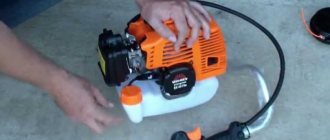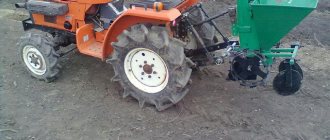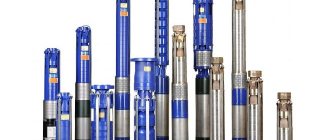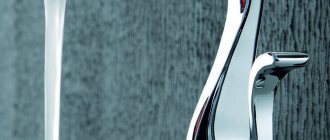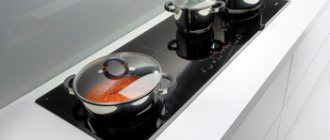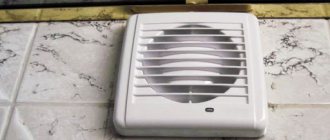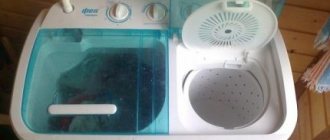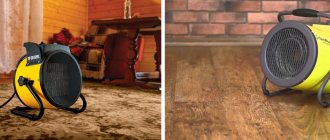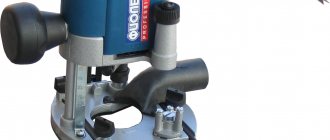An edge router will provide high-quality lateral processing of the edges of workpieces, help create grooves and select grooves, make grooves, chamfer and round corners of parts.
This tool will allow you to carefully work with wood materials (including those covered with laminate or veneer), drywall and tiles.
In this review, we consider the criteria for choosing an edge router, the best corded and battery-powered models.
Page navigation:
What does drying out lead to?
A typical case: you made a shed at your dacha to store household equipment and for other needs. They did it for themselves, so they pulled together the boards from which the walls were made, carefully, without the slightest crack. Two or three months pass; the boards dry out and the entire wall glows with cracks. In winter, snow blows through them; in summer, the wind blows dust inside the barn.
Shrinkage reaches 10-13% of the linear size. That is, a board with a width of 100 mm after drying is reduced to 88 mm.
To prevent this from happening, you need to use quarter boards for wall cladding. A wall covered with such boards will never have through gaps. With their quarters, neighboring boards overlap each other and when they dry out, through cracks no longer appear.
Unfortunately, lumber is very rarely sold with a quarter finished. Therefore, an amateur craftsman should know the ways in which boards can be modified if necessary.
Quarter selection sequence
- We adjust the reach of the saw blade so that the cutting depth is equal to half the thickness of the board being processed. The easiest way to do this is right on the spot. To do this, place the board on the side of the saw blade, as shown in the photo, and adjust the reach of the blade.
We install a parallel stop on the machine so that the width of the cut is also equal to half the thickness of the board. We take into account the thickness of the disk itself. This completes the machine setup.
We make longitudinal cuts on opposite sides of the board.
We make cuts from the ends of the board. A quarter is ready. As a by-product we get glazing bead)).
Alternative methods
As mentioned, a stationary circular saw is very convenient for selecting quarters. (There is a separate article on our website about the types of circular saws and the features of their choice.) But it is not always in the master’s arsenal, and sometimes it is physically impossible to use it.
If you need to cut quarters out of thick, long boards, you can use a hand-held circular saw. The manufacturing principle and sequence of operations are the same. The difference is that in this case the board being processed and the tool change places. The board is fixed motionless, and the master moves the circular saw with a parallel stop along it manually.
If you don’t have a circular saw or a hand-held circular saw at hand, you can use a grinder with a wood blade or a hand router with a suitable cylindrical cutter. Both methods are very slow and are not suitable for large volumes of work. In addition, choosing a quarter with an angle grinder is inconvenient, dangerous and turns out uneven.
Read also: Presentation on heat treatment of metals and alloys
Another way is to use an electric plane. However, most modern plane models are not suitable for this due to their design features. Watch the video that shows just this method of choosing a quarter.
Getting started and caring for the tool
To understand how this device works, you should familiarize yourself with its main parts and their purpose.
Composition and purpose of main components
A manual milling device consists of a metal body and a motor, which is located in the same body. A shaft protrudes from the housing, onto which various collets are placed, serving as adapters. They allow you to install cutters of various sizes. The cutter is inserted directly into the collet, which is secured with a special bolt or button, which is provided on some models.
The main elements of a manual milling device and their purpose.
The design of the milling device includes a metal platform, which has a rigid connection to the body. It is attached to the body by means of two rods. On the outside, the plate has a smooth coating that ensures smooth movement during operation.
The manual milling device has some characteristics that can be adjusted:
- Due to the handle and scale for adjusting the milling depth. Adjustment is carried out in 1/10 mm increments.
- By adjusting the rotation speed of the cutter.
At the initial stages, when mastering the tool, it is better to try to work at low or medium speeds. Although you should always remember that the higher the speed, the better the work. Especially if this concerns critical, visible areas that cannot be masked.
In addition to these levers, there is also a button to turn the product on and off, as well as a lock button. These elements are considered basic, ensuring high-quality and safe performance of work. There is also a parallel stop, which contributes to ease of use. It can be rigidly fixed or with the ability to adjust the shift of the working area away from the center.
Caring for a hand-held milling device
Usually, a factory product ends up in the hands of a person tested and lubricated, so no additional measures should be taken. Only during its operation you need to monitor its cleanliness and serviceability. At the same time, it should be regularly cleaned of dust and the lubricant should be changed, if so written in the passport. Lubrication is especially necessary for moving parts. As an option, you can use aerosol lubricants, but you can also get by with regular ones, such as Litol. The use of thick lubricants is not recommended, as chips and dust stick to them. If aerosol lubricants are used, then this factor can be eliminated.
The sole, the smooth part of the body, also requires lubrication. Regular lubrication will ensure smooth movement.
Despite this, the purchased item should definitely be checked for quality of assembly and presence of lubricant.
Unfortunately, not all manufacturers, especially domestic ones, care about build quality. There are cases when, after the very first hours of operation, screws or screws are unscrewed from a product because they were not tightened properly.
Rotation speed adjustment
The operation of any tool is associated with certain conditions related, first of all, to the nature of the material being processed. It can be plywood, composite material or regular wood. Depending on this, the rotation speed on the electrical appliance is set. As a rule, the technical data sheet always indicates the operating parameters of the device, depending on the technical characteristics and characteristics of the surfaces being processed, as well as the cutters used.
Indicators of processing speeds when using various cutters.
Fixing the cutter
The first thing the work begins with is installing and securing the cutter. At the same time, you should adhere to the basic rule - all work is performed with the cord plug removed from the socket.
The cutter is installed according to certain marks, and if they are missing, then to a depth of no less than * the length of the cutter itself. How to install a cutter on a specific model can be found in the instructions, which must be included in the technical documents for the device. The fact is that each model may have its own design features and it is not possible to talk about this in the article.
Installing the cutter on the device before starting work.
There are both simple and more “advanced” models, as they say. Some models have a shaft rotation lock button, which makes installing the cutter easier. Some, especially expensive models, are equipped with ratchets. So it won’t be possible to specifically describe the process of installing the cutter, and it doesn’t make sense, since everyone who is familiar with the operation of such devices will figure it out in a moment.
Milling depth adjustment
Each model has its own maximum milling depth. At the same time, it is not always the maximum depth that is required, but a certain depth that is set before work. Even if maximum depth is required, in order not to overload the device, the milling process is divided into several stages, changing the milling depth in steps. For adjustment, special stops are provided - limiters. Structurally, they are made in the form of a disk located under the bar, on which stops of various lengths are fixed. The number of such legs can be from three to seven, and this does not mean that the more there are, the better. It is better if it is possible to adjust each of the legs, even if their number is minimal. To secure this stop in the optimal position, you should use a lock in the form of a flag.
The process for adjusting the milling depth is as follows:
- The tool should be placed on a flat surface, after which the clamps are released and the cutter is pressed with your hand so that it rests against the surface.
- By unscrewing the lock, the turret stop is released.
Choosing a turret stop leg. - The leg that corresponds to the milling depth is selected, after which the disk with the legs is installed in the correct position.
- In this case, the screw is not fixed, and the bar is held with a finger. After this, the movable pointer moves so that its readings coincide with the zero mark.
- Then the rod rises to the mark that corresponds to the milling depth and only then the turret stop lock is lowered (photo below).
Thus, the workpiece is milled to a given depth.
On high-quality, expensive models there is a wheel for precise adjustment of the milling depth.
Using this wheel, you can more accurately set the depth without disturbing the previous setting.
This wheel (green in the photo above) allows you to adjust the depth within small limits.
How to choose a quarter on a board
Knowing some tricks, you can save a lot during construction. True, you will have to spend a little more time, but when working on a large scale, the savings will be significant.
The most common way to reduce the cost of purchasing lumber is to buy second-class products to give them the desired look with your own hands.
How to choose a quarter on the board yourself? To get started, purchase a board of 2 grades. This can be done on the website of our company Mosbrustorg. Our prices will help you keep your budget while still getting the required amount of material.
After purchasing a board of a simple configuration, you can select a quarter in the board using a circular saw or electric planer. Then carefully decorate the edges and now you have a product whose price is twice as high.
The work begins by making a cut from the end of a regular board with a depth equal to half the height, and then making a cut in the middle of the end. Next, use a ruler to measure the width of the future product. The depth should be twice as large as half the height due to the fact that the sawn-off part will have to be removed later.
As a result, from second-rate raw materials you will receive a product that will be distinguished by its positive properties.
The quarter board has the following characteristic features:
- excellent thermal insulation;
- aesthetic and presentable appearance;
- excellent attribute for decoration;
- Excellent material for exterior cladding.
Edged boards at low prices from the Mosbrustorg company are an excellent solution for the wholesale purchase of lumber. We will not only give you a discount, but also load the goods for free when you pick them up yourself.
How to choose a quarter using a circular saw
Using a circular saw to make the quarter board will make the process much easier. If the tool is of high quality, has sharp blades and works at good power, this will help you a lot. After all, now you can set the necessary values and not be afraid to cut off the excess.
How to select a quarter on a board using a circular saw? The process is not much different from the usual one, the only thing is that you now have a circular saw in your hands. A cut is made from the end of the board with a depth of half the height of the board. Next, a second cut is made in the center of the end. Next, we take the necessary measurements and cut it so that the quarter takes on the required shape.
Electric planer - how to choose a quarter on a board
An electric planer is a convenient tool for woodworking. With its help, you can cut the wood evenly and get the product of the required shape. How to select a quarter on a board using an electric planer? The process is no different from working with a circular saw. The only advantage of working with this tool is ease of use and a clearer vision when performing a task.
Such work will help you from a cheaper product to independently produce a high-quality product that is perfect for decorating and finishing a room both inside and outside.
Why do you need a milling machine?
The milling device is designed for processing both wood and metal. With its help, it is possible to form recesses or holes of any configuration. This greatly simplifies tasks such as inserting hinges and inserting locks. Doing this with a chisel and an electric drill is not so easy, and it takes a lot of time.
There are stationary milling devices and portable (manual). Hand-held electric milling machines are considered universal devices, with the help of which, in the presence of attachments, it is possible to perform operations for various purposes; you just need to change the position of the part in relation to the device or vice versa.
Stationary devices are used in factories or factories where mass production of wood or metal products is established. Under such conditions, the cutting attachment is stationary, and the workpiece moves along the desired path. When using a hand tool, on the contrary, the part is fixed motionless and only then it is processed, although there are parts that require fixing a hand tool. This is provided for in the design, therefore, it is considered more universal. This is especially true when a large number of parts need to be processed, and it is not possible to use a stationary machine.
A homemade milling machine is a horizontal platform with a hole in the center, to which a hand-held device is attached from below.
There are many types of milling machines, but for use at home or for starting your own business, universal models are more suitable. As a rule, they are equipped with a set of cutters and various devices for performing various types of operations. The only thing is that if you have a manual milling cutter, simple operations can take much longer than when using a stationary machine.
Using a manual milling device it is possible to:
- Make grooves or recesses of any shape (curly, rectangular, combined).
- Drill through and non-through holes.
- Process ends and edges of any configuration.
- Cut out complex shaped parts.
- Apply drawings or patterns to the surface of parts.
- Copy parts if necessary.
Copying parts is one of the functions of any electric milling machine.
The presence of such functions makes it possible to simplify the production of the same type of furniture or the production of identical parts not related to furniture production. This is one of the main advantages of this tool. As a rule, to produce parts of the same type, it is necessary to install copying machines, which are designed to perform only one operation, which is not always profitable, especially in small enterprises.
Some tips
- Don't forget about safety precautions.
- If the boards are long, work with an assistant.
- The boards must be the same thickness.
- Do not use freshly cut lumber. Let them dry for at least 1 year.
In the following articles we will continue the story about woodworking techniques and the tools used.
Milling cutters are classified mainly by their purpose and shape. The most common of them are profile, grooved, for cutting quarters, for chamfering, conical for cutting grooves and dovetail joints. In addition, the home carpenter, although less often, has to deal with such wood cutters for a manual router as end cutters, fitting cutters, type cutters, for processing edges and ends for gluing, and also for cutting out a T-shaped groove.
What features of edge routers should you pay attention to when choosing?
The key parameters of edge routers that you should pay attention to when choosing include the following:
- Type of food. You can find both corded and cordless edge milling machines in stores. The former are characterized by increased power and better performance, the latter, being completely autonomous devices, allow you to work in conditions with no power grid.
- Power consumption. This characteristic is related to the performance of the unit. A powerful milling cutter will provide high speed operation, no engine heating under prolonged loads, and the ability to use different equipment. For household use, a device with a power of 400-600 W is suitable; for regular use at a professional level, equipment with a power of 600-900 W is recommended.
- Maximum speed. Low speed models are suitable for processing soft materials. High router speeds are recommended if you need to work on hard surfaces.
- Milling depth. Depending on the model and class of the unit, there are milling cutters with a tool stroke from 20 to 80 mm. This parameter is related to the depth of the grooves created and the thickness of the workpiece being processed.
- Functionality. Useful options increase the productivity of the router and the ease of working with it. The speed regulator allows you to adapt to materials with different densities, smooth start minimizes the starting jerk, protection against accidental start and automatic shutdown in case of overload are responsible for the safety of the device and the user.
Blind selector
The device consists of two rulers (one on each shoulder of the groove) and two rods that rest on the edges of the workpiece. One ruler and one board are T-shaped at right angles. Gaps along the other strip and ruler allow you to install boards up to 300mm wide and select grooves up to 38mm wide. Two clamps in the adjustable bar are supported in the workpiece and secure the device in place.
To work, you need a set of guide bushings for the router. In this case, the ruler bushings should be slightly shifted to the side relative to the width of the groove.
The device is made of poplar, but Karelian birch plywood or MDF is also suitable. The T-nuts and MB screws are recessed so the cutter can slide over the lines without obstruction.
After production is completed, it is necessary to make inserts for installing the ruler. A piece of edged board about 450 mm long, 150 mm wide and 20 mm thick, cut to the same thickness along its entire length. It all depends on the size of the sleeve and cutter. Leave the tool in place, making four inserts, about 50mm long, about 25mm wide and equal to the thickness of the gaps. Ideally, the thickness of the liners should be equal to half the difference in diameter between the cutter and the sleeve.
READ How to Disassemble a Screwdriver Chuck Video
Fine adjustment of the inserts is carried out when using them with installed rulers when milling along a short cut that was previously cut. Unscrew the adjustable ruler, place the trim between the rulers and the two inserts on each side.
Tighten the screws. Remove the liners, cut and mill the groove. If the cutout does not fit into the groove, adjust the thickness of the liners.
Review of the best network edge routers
Network models are distinguished by decent characteristics, low price and reliability . They are always popular among users.
Rating of the TOP 5 best network edge routers for wood in terms of price and quality ratio.
Makita RT0700CX2, 710 W
The Makita RT0700CX2 edge router, equipped with all sorts of functions, is ideal for processing the edges of wood products that have a flat shape.
The model provides the ability to create curly, oblique or rounded edges.
In addition, the device will help in creating grooves of various shapes.
The tool is equipped with a rotation speed control system from 10,000 to 30,000 rpm, a spindle lock for quick replacement of working equipment, and a guide sleeve that allows cutting according to a template prepared in advance.
The cutting depth is adjusted using a rubber roller.
The product delivery set includes collets, keys, and other accessories and fixtures.
Specifications:
- power consumption - 0.71 kW;
- maximum speed - 30,000 rpm;
- milling depth - 3.5 cm;
- collet sizes - 6 mm, 8 mm;
- functionality - speed control, rotation stabilization, soft start, turret stop, fine tuning, spindle lock, vacuum cleaner connection;
- device weight - 1.8 kg.
Advantages
- high quality workmanship;
- rich functionality;
- good equipment;
- ease of use.
Flaws
- storage case too large;
- short stop rods;
- high noise level.
Makita RT0700C, 710 W
The Makita RT0700C edge milling machine, operating in a speed range from 10,000 to 30,000 rpm, will allow you to process materials such as wood, chipboard and fiberboard with ideal results.
The device is equipped with a smooth speed control system, a cutting depth limiter, a spindle lock, and overload protection.
The device allows milling with a maximum depth of 25 mm.
Additionally, the device is equipped with a speed stabilization system under load.
The instrument is connected to the power supply using a 2.5 m cable.
The delivery set includes a straight guide, 6 and 8 mm collets, and keys.
Specifications:
- power consumption - 0.71 kW;
- maximum speed - 30,000 rpm;
- milling depth - 3.5 cm;
- collet sizes - 6 mm, 8 mm;
- functionality - speed control, rotation stabilization, soft start, spindle lock, connection for a vacuum cleaner;
- device weight - 1.8 kg.
Advantages
- optimal power;
- presence of speed control;
- high-quality materials and assembly;
- convenient round platform;
- two types of collets included.
Flaws
- the metal cylinder is susceptible to scratches;
- not the best ergonomics;
- high price.
Wortex MM 5013-1 E, 710 W
The Wortex MM 5013-1 edge miller with a powerful 710 W electric motor will provide high-quality edge milling of wood, plywood and laminate products.
The presented product is characterized by compact dimensions.
The ergonomic design of the case makes it easy to hold the model in your hands.
The milling cutter supports work with 6 and 8 mm collets, the device is equipped with a system for smooth adjustment of the immersion depth.
The device is equipped with collets, a pipe for dust extraction, a parallel guide, a stop, carbon brushes, a key and operating instructions.
Specifications:
- power consumption - 0.71 kW;
- maximum speed - 30,000 rpm;
- milling depth - 2.2 cm;
- collet sizes - 6 mm, 8 mm;
- functionality - speed controller, spindle lock, vacuum cleaner connection;
- device weight - 1.45 kg.
Advantages
- Ease of use;
- compact dimensions;
- light weight;
- excellent performance.
Flaws
- vibration during operation;
- case heating under load;
- short power cable.
Makita 3709, 530 W
Makita 3709 corded edge router with 530 W electric drive power, supporting the installation of a cutter with a 6 mm collet.
It is the ideal solution for precision machining of wood, plasterboard, composites or ceramics.
The tool also allows you to create holes and select grooves in materials.
The device has small dimensions and weight, the product will be convenient when performing work with one hand.
The milling cutter is equipped with a transparent base, which provides comfortable observation of the working area of the tool and adjustment of the movement of the equipment.
The instrument receives power from the network; it is connected to it with a 2.5 m long network cable.
The device is equipped with a rip fence, a contour guide, a collet, a cutter, keys and a template guide.
Specifications:
- power consumption - 0.53 kW;
- maximum speed - 30,000 rpm;
- milling depth - 4.0 cm;
- collet dimensions - 6 mm;
- functionality - engine cooling;
- device weight - 1.5 kg.
Advantages
- ease of use in general;
- reliability of design;
- decent equipment;
- possibility of working with one hand.
Flaws
- fragile plastic sole;
- limited selection of cutters;
- poor functionality.
BOSCH GKF 550 Professional, 550 W
The BOSCH GKF 550 Professional network edge router, equipped with a 550 W motor and weighing only 1.4 kg, is a convenient solution for efficient and precise processing of all kinds of materials.
The device is equipped with a parallel stop, a cutting depth limiter, and a roller guide.
The design of the router provides a protective wall.
The unit provides rotation speeds of up to 33 thousand revolutions per minute. The diameter of the collet chuck is 6 mm.
The product is equipped with a parallel stop, a copy sleeve, a roller guide, and 10 and 17 mm wrenches.
Specifications:
- power consumption - 0.55 kW;
- maximum speed - 33,000 rpm;
- milling depth - 4.1 cm;
- collet dimensions - 6 mm;
- functionality - parallel stop, copying sleeve;
- device weight - 1.4 kg.
Advantages
- light weight;
- compactness;
- high engine speeds;
- affordable price.
Flaws
- basic functionality;
- lack of protection against accidental activation;
- no cutters included.
Profile cutters for hand router
A profile cutter is a fairly broad concept, which applies to many basic types of cutters: for cutting grooves (grooves), quarter cutters, and, as one of the options, for rounding corners and edges.
To form complex profiles, you can use successively several different wood cutters for a manual router of this type, or only the so-called multi-profile cutter.
Among the wood cutters for a manual router for rounding corners and edges, there are also three-radius ones, capable of forming roundings along any of their radii or all at the same time.
Chamfering cutters can be of different diameters with cutting edges inclined to the axis of rotation at 45, 55 and 60°. These cutters have only side cutting edges and, as a rule, a lower thrust journal or thrust bearing. In contrast, grooving cutters also have cutting edges at the lower end.
Milling cutters for hand milling tools
A milling cutter is a cutting tool that can have an intricately shaped cutting edge. As a rule, all cutters are designed for rotational movements and therefore have a cylindrical shape. The shank of the cutter, which is clamped in the collet, has the same shape. Some cutters are equipped with a thrust roller, so that the distance between the cutting surface and the material being processed remains constant.
Milling cutters are made only from high-quality metals and their alloys. If you need to process soft wood, then HSS cutters will do, and if you need to process hard wood, then it is better to use cutters made of harder HM alloys.
Each cutter has its own technical characteristics, which provide it with high-quality and long-lasting performance. The main indicator is the maximum speed of its rotation, which should never be overestimated, otherwise its breakdown is inevitable. If the cutter is dull, you should not try to sharpen it yourself. Sharpening of cutters is carried out using special, expensive equipment. After all, you need not only to sharpen the cutter, but also to maintain its shape, which is no less important. Therefore, if for some reason the cutter becomes dull, it will be cheaper to buy a new one.
The most popular cutters
There are cutters that are used in work more often than others. For example:
- Edge cutters. With their help, the end surfaces of wooden blanks are cultivated. In addition to the curved edge, they can be used to form spikes or grooves to connect parts. Such cutters may have a bearing at the end that rests on the part, setting the processing distance.
Some types of edge cutters. - Groove cutters. These are cutters for forming grooves of various shapes. They, in turn, are:
- Spiral (a) - used to form technical grooves, such as tongue/groove.
- Fillet (b, d) - used for finishing surfaces in the form of grooves of various shapes and depths. They can be rounded, V-shaped or curly.
- Dovetail (c, d) - used to create a specially shaped groove intended for hidden or open connection of wooden parts.
- Shaped (d) - intended for decorating wooden surfaces. As a rule, they help create free-form grooves.
Groove molds are designed to create recesses in any location on the workpiece.
There are cutters that are simple, monolithic, made from a single piece of metal, and there are typesetters. Set cutters consist of a shank, which serves as the basis for a set of cutting elements. By selecting cutting planes and installing them on the shank, using washers of various thicknesses, you can form an arbitrary relief on the surface of the workpiece.
A set cutter is a set of cutting surfaces and washers that allows you to assemble a cutter of the desired shape.
In fact, there are a lot of cutters and this is only a small fraction of what is produced. All cutters differ in the diameter of the shank, the diameter of the cutting surfaces, their height, the location of the knives, etc. As for manual milling equipment, it is enough to have a set of five of the most common cutters. If necessary, you can purchase them at any time.
Wood slotting cutters for router
Groove cutters have side and end cutting edges, which allows them to be inserted into the workpiece being processed anywhere and processed by moving the milling machine in the desired direction. The main and secondary cutting edges ensure clean machining of the side walls and bottom of the groove.
Of all the groove cutters, cylindrical cutters are most often used, in particular, for making grooves, quarters and slots, drilling holes, cutting straight tenons, making recesses (sockets) in workpieces, half-timber joints, as well as when working with copy sleeves and templates .
wood cutters for a hand router with straight cutting edges can have diameters from 2 to 30 mm, and cutters with spiral cutting edges can have diameters from 3 to 8 mm (with a 08 mm shank). Spiral cutters better remove chips generated during processing of workpieces. The groove group also includes cutters for cutting tenons (including dovetail tenons, the cutting head of which tapers towards the shank at an angle of 15°).
To select grooves on the edges of workpieces, circular groove cutters for wood are used for a hand router, working on the principle of a circular saw. Their thickness is usually in the range of 1.5-6 mm with a diameter of 40-60 mm. If it is necessary to select wider grooves, several passes are made with a milling cutter. When making a groove in the middle of the edge, the workpiece is turned to the other side after the first pass. Then the distance from the groove walls to the workpiece faces will be the same.
How to choose a tool
Professional furniture makers are not born experienced; they also purchase equipment for the first time. However, despite the specificity of the work, the edge router is no less popular in everyday life, so you need to approach the choice responsibly so as not to overpay for unnecessary functionality, but also not to end up with inappropriate equipment on hand.
Scope of application
Household milling cutters are characterized by low power in the range of 350 – 550 watts. They are designed for occasional work that does not last long. The service life of the engine and other parts is short, but the price of such power tools is moderate. A characteristic feature of household edge trimmers is their limited functionality. Here you will hardly find a rotating frame or rich equipment.
Expert opinion
Levin Dmitry Konstantinovich
A professional tool is, above all, reliability. Advanced milling cutters for chamfering and edge milling are designed for continuous operation for several hours a day. Convenient for furniture shops and woodworkers.
The power of devices usually starts at 700 W, but it cannot be too high, as it requires the installation of a large, heavy motor that will be awkward to hold in your hands. Professional tools often come with different options for frames and attachments, which allows you to get impressive functionality.
Power
Edge routers do not require a lot of power. The parameter range ranges from 350 W to 1.3 kW. Low-power devices are convenient for removing small amounts of material and for fine milling. To work on hardwood, it is better to opt for a more powerful device.
Tooling diameter
Replaceable cutters have a standard shank size for fixing in a collet.
Small hand routers, working to a depth of up to 25 mm and held with one hand, are equipped with collets for 4 or 6 mm shanks. Powerful units allow the installation of equipment with a shank diameter of 10 mm. What edge router do you use?
HouseholdProfessional
Speed adjustment
Useful for working with different types of materials. Particle boards are processed at lower speeds, MDF allows higher speeds for better accuracy. The need to reduce the speed of the cutter is necessary in order to prevent smoking and charring of the binding glue in the composition of wood boards or resin in solid wood. Therefore, for example, coniferous trees are milled at a lower speed.
Milling depth
Ranges from 17 to 55 mm. Milling to greater depths requires adequate power. A large cutter stroke is needed for thick furniture panels made of solid wood and pressed boards, otherwise the edge cannot be processed over the entire thickness. For decorative and artistic milling of MDF products, a cutter stroke of 25 mm is sufficient.
Making planks with grooves at home
Often you have to make furniture or make repairs at home, using the simplest methods and what is at hand.
If you need to make a groove in the board with your own hands, be patient and have the necessary tools:
- A circular saw. The most practical tool, but, unfortunately, not everyone has it.
- A regular hacksaw for wood. It will take longer to work with it, but this accessory can be found in every home.
- Electric drill. It is also quite accessible, but before making a groove in a board with a drill, it is advisable to practice on an unnecessary block, practicing the skill.
Making a groove with a circular saw
Making a groove with a circular saw.
The optimal materials are wooden boards, bars and the like. The price of raw materials is minimal; in extreme cases, what is available on the farm is used. The most successful solution is a through, single open straight end connection.
The joint will be strong and reliable:
- It is recommended to make tenons with a thickness of ¼ of the thickness of the plank and a groove of the same size.
- The height and length of the groove must correspond to the dimensions of the plank.
- Prepare a pencil and ruler for marking.
- Decide on the coordinates of the cut and mark it.
- The cut should be made along a line inside the side that will then be separated.
- For a circular saw, the instructions recommend a blade width of 2-4 mm.
- Sawing in the middle of the marked line removes 1-2 mm of excess, since two grooves are made on each plank.
Note! To prevent the workpiece from being damaged, make cuts along the inner sides of the drawn lines. In this case, a visual correction is made for the thickness of the canvas.
- If you need to join two parts at a 90º angle, cut the pieces at 45º at the ends.
- For an end-to-end open miter connection (single straight), mark the cut locations on the oblique cuts of the planks.
- Before removing the groove from the board, double-check that the cut is correct on all sides.
- For an angular single connection that is not through the eye, an eye is made instead of a groove. In this case, the width of the tenon is left unchanged, and the length will be 0.3-0.8 of the width of the board being attached.
- Since the circular saw rounds the edges of the eye, leaving the shape of the tenon unchanged, it is advisable to refine the corners by turning them with a rasp.
Groove using a drill
The photo shows a groove being cut out with a drill.
The method is quite labor-intensive, but it can be called an alternative to the one described above. If you were unable to get a hand router, prepare a drill and chisel, ruler and pencil.
- Select a drill with a diameter corresponding to the width of the future groove.
- To guess the depth of the groove, you can make a mark on the drill itself (for example, draw it with bright paint).
- Draw two parallel lines along the block at the required distance from each other.
- Having secured the workpiece in a vice, drill a furrow, carefully monitoring the vertical position of the drill and maintaining the depth.
- When finished, remove all excess with a sharp chisel and sand with emery cloth.
Note! It happens that a furrow with a concave bottom and a spike with a convex end are required. Before making the moon groove in the board completely, drill to a depth slightly less than required. Subsequent processing and adjustment can be conveniently done with coarse sandpaper or a round file.
Using a hacksaw on wood
Making a transverse groove with a hacksaw.
Well-done markings will help a lot here.
Select a hacksaw blade that is smooth and durable:
- To avoid mistakes, draw two lines along the length of the board, on opposite sides. The distance from the top plane to them will be the depth.
- Securely secure the block and begin sawing.
- It is important to monitor, checking the lines, how far the canvas fits into the wood.
- If the tool is skewed, you can ruin everything, so periodically watch the hacksaw’s entry into the material from the side angles.
- With a wide groove and a thin blade, it is more effective to make two cuts, again along the inner sides of the cut.
- All excess is carefully removed with a chisel and cleaned.
What can you do with a hand router?
Of course, we are unlikely to be able to list all those useful things that can be made at home if you have a hand router, certain skills and desire due to the unlimited range of such crafts, but we will still mention the most common of them, and if necessary, you can easily find Photos of such homemade products on the Internet.
So, armed with a hand router, even a novice craftsman can easily cope with the manufacture of railings, all kinds of racks and shelves, hangers and stools. Now it has become fashionable to breathe new life into old, shabby furniture at home, and this process will definitely be within your power.
Also, a hand router will be indispensable where it is necessary to select grooves for future connections, insert a lock, and even create a fancy intricate pattern on the surface of the wood that serves as a decorative decoration. Even if you don’t plan to hold such a versatile tool in your hands around the clock, sooner or later it will definitely serve you well in everyday life.
Basics at work
The cutting depth here is regulated by a lifting mechanism that connects the two main parts of the router - the electric drive and the base. To be more precise, the parameters for deepening the cutter into the material being processed are set by setting a certain distance between the pin and the washer located next to the motor. To ensure that the milling machine maintains the same distance relative to the edge of the workpiece when moving, it is equipped with a straight guide. Some models are equipped with a circular guide, with which it is possible to mill circles with a large radius . For small circles (radius less than 15 cm), technological holes are provided on the base of the equipment into which a centering pin is inserted at a specified distance from the cutter.
Grooving is carried out using an angular stop mounted on the machine body at a right angle. Before starting work, the carpenter must ensure that the workpiece of the future product is in a stationary position, because the lack of reliable support will inevitably lead to the fact that the edges of the groove will be crooked, and this will negatively affect the final result of the work. Please note that it is not recommended to remove a layer of wood exceeding 5 mm in one pass. According to the technology, sufficiently deep grooves are selected in several steps. Working with a hand router on wood should be done smoothly, without haste or sudden movements, otherwise you will have to deal with such an unpleasant phenomenon as torn edges of the groove.
Setting up the tool and getting started
A wood router, like any other equipment, needs adjustment before starting the work process. First of all, remove the safety nut and the collet, after which the unit is started and a control cut is carried out. Next, check whether the screws and other threaded parts are tightened well and remove excess protective lubricant.
Beginners often make the mistake of not holding the milling machine tightly enough in their hands, or applying excessive force to the material being processed. At the corners of the workpiece, as well as when changing the direction of movement of the milling cutter, the speed of movement of the unit is not slowed down so as not to leave burns due to overheating of the machine.
Quarter cutters (READING)
Such cutters differ from cylindrical slot cutters by the presence of thrust pins or bearings that guide the cutter along the edge, thereby ensuring the same width of the selected quarter. If it is necessary to select a narrower or wider quarter, replace the thrust bearing with another of the appropriate diameter or use a different cutter.
Read also: How to saw concrete with a grinder
If the cutter and its thrust bearing are of the same diameter, then such a cutter is considered as a fitting cutter (sometimes called “overrunning”), which is used to process edge overlays, veneers, etc. flush with the workpiece.
If the cutter has a thrust pin that rotates with the tool, traces from this pin remain on the processed base surface, which you have to put up with. Thrust bearings do not leave such marks behind them.
In addition, they produce prefabricated cutters and sets of cutters for various purposes (for example, for the production and subsequent connection of parts with a complex profile).
Seam using an electric plane: step-by-step instructions
Step #1
First, the workpiece is placed on a carpentry bench and secured as tightly as possible with clamps. The fastener should be on the opposite side of the processing area.
Step #2
After this, the instrument is prepared. Set the angle stop at the required distance from the part. This way it will provide the required planing width and a 90° angle between the tool and the edge of the part.
Read also: How to connect the motor from an automatic washing machine
Step #3
A depth stop is screwed onto the right side of the power tool.
Step #4
The cutting tool of the device should be installed as close as possible to the right edge of the sole.
Step #5
When everything is ready, turn on the electric planer and select the fold, pass by pass. Setting the maximum planing depth in one pass is not advisable. This point must be coordinated with the recommendations of the tool manufacturer.
Step #6
After the depth stop rests on the wood, work is stopped. The fold is ready.
If necessary, chamfer the edges of the part. This will help prevent the edges of the corner surfaces from splitting. For ease of chamfering, slots of different sizes are provided on the base of the power tool.
After reading the article, the reader will be able to learn about the purpose and use of rebates in carpentry, and will be able to make a selection of quarters with an electric planer independently.
Rules for working with hand milling tools
Working with power tools requires special rules, especially when there are rapidly rotating elements. In addition, as a result of work, chips are formed that fly in all directions. Despite the fact that most models are equipped with a protective shield, this does not fully protect against the flow of chips. Therefore, it is better to work with such a tool wearing safety glasses.
The photo shows a model where a vacuum cleaner is connected to remove chips.
General requirements
If you follow the basic requirements for safe work with an electric hand router, the end result will please you with the quality of work and a safe outcome. These are the conditions:
- You should always use only sharp tools. How sharp a cutter is can be judged by the quality of the surface treatment. In addition, in such conditions the engine begins to get very hot.
- The material that needs to be processed must be securely fastened, otherwise normal operation will not occur.
The use of clamps for fastening the workpiece. - It is not recommended to remove the entire surface in one pass, as this increases the load on the cutter and the tool (motor). This entails a decrease in processing speed, and therefore a decrease in quality. Therefore, if the depth is decent, then it is better to remove the excess several times.
- The cutter is replaced only when the unit is de-energized, and turning it off with a switch alone is not enough. It is necessary to remove the plug from the socket.
The requirements are not very complex and quite feasible, but ignoring them means exposing yourself to danger. And one more thing, no less important, is the ability to hold a milling tool in your hands and feel how it works. If serious vibrations are felt, then you need to stop and analyze the reasons. It is possible that the cutter is dull or there is a knot. Sometimes it is necessary to correctly set the rotation speed of the cutter. Here you can experiment: either add speed or reduce it.
Special cutters
When making decorative selections, for example, ornaments, fonts, V-shaped (conical) engraving cutters are used. In this case, the milling machine is moved along the markings freely by hand. For drilling and making holes, cutters with a stop center and a trimmer are used. Holes for dowels are drilled with cutters 06, 08 and 012 mm. Sockets for furniture fittings are selected with cutters 015-35 mm. When working with cutters of larger diameter, the milling machine should be switched to lower speeds.
With the help of some cutters it is possible to form two mutually matching profiles, one of which is a counter profile. This can be a set of two separate cutters that complement each other (“profile-counter-profile”), or one cutter that creates its own counter profile when turning the workpiece to the other side.
Shank Diameter Types
Before you start choosing a cutter, you should first decide on the fastening method, namely in what units the diameter of the shank will be measured - in millimeters or inches.
This will depend on what kind of collets are included with the router - bushings into which the shank itself is clamped:
- If the size is measured in millimeters, then the most common ones will be 6.8 and 12 mm.
- When the dimensions are written in inches, you can choose only one of two - ¼ and ½ inches.
Please note that when converting inches to units, the results are 6.35 mm and 12.7 mm, but despite the small difference, the millimeter shank does not fit with the inch collet and vice versa. The shaft of a milling machine rotates at a speed of up to 25,000 revolutions per minute, and therefore even such minor discrepancies can lead to at least damage to the tool.
Material for wood cutters
Milling cutters are made from high-speed steel (more affordable), from carbide (expensive) and with carbide brazed plates. The durability of carbide blades exceeds that of high-speed steel blades by almost 25 times. These cutters can also be used for processing materials with a high adhesive content (for example, chipboard and MDF boards), difficult-to-cut wood (for example, teak), plastic and aluminum. However, when processing soft wood, the best results are obtained with high-speed steel cutters, the blades of which can be sharpened.
A worthy alternative to these two types of cutters are cutters with removable, rotating, non-sharpenable carbide plates, which, in comparison with cutters with sharpened plates, are more economical (suffice it to say that sharpening a cutter sometimes costs almost twice as much as its cost). Removing and putting the cutting plates in a different position is a very simple matter.
The advantage of cutters with removable and rotating plates is that their working diameter remains constant. When sharpening the blades, it gradually decreases.
There are cutters with removable rotary plates: grooved (08.010 and 012 mm), for milling around the perimeter - 016 mm, fitting, for chamfering and quartering. Due to the high peripheral speed, large-diameter cutters are used only on stationary milling devices. Of course, the range of cutters is constantly expanding, and thanks to this, the technological capabilities of home craftsmen can also expand.
These are not all cutters for a hand router. There are many of them and we will try to tell you about them all.
Please advise which tool to use to select a quarter in the boards. The work is not regular, as needed. The boards are supposed to be used for cladding.
VG wrote: Please advise which tool to choose a quarter in boards
a manual circular saw in two passes, a stationary circular saw, if you place two discs through a washer, then in one pass. with a plane in 4-6 passes (not all models choose a quarter, the depth at a time is 2 mm.) with a groove cutter and a hand router. -1 pass. (the disadvantage of the cutter is that it is almost impossible to sharpen; it sits quickly.) with a disk cutter on a universal machine. and by hand with a plane
here's a cutter for you" > on a circular saw in one pass.
Thanks for the detailed answer. There is a manual circular saw and an electric planer. It is not very clear how to pass the thickness with a circular saw (if in two passes). For example, if the board is 20. Circular cutter, for production in one pass - suitable for manual or not? I've never seen anything like this in a store. Is it interesting that they sell it in St. Petersburg? Another question about the router (I’m thinking about buying it or not). If they choose a quarter, how many meters (approximately) will the cutter last? In general, does it make sense to buy it for this and work like: making skirting boards, tongue and groove floorboards, etc. for small volumes - 20-30 m?
VG wrote: Circular cutter, for manufacturing in one pass - is it suitable for manual or not?
I haven’t tried it, but the gearbox should pull.
VG wrote: If they choose a quarter, how many meters (approximately) will the cutter be enough?
50 meters should be enough, then the edge needs to be corrected
VG wrote: approximate) In general, it makes sense to buy it for this and work like: making plinths, tongue-and-groove floorboards
absolutely not . Even a two-kilowatt cutter won’t handle such cutters; the diameter of the cutters needs to be large. here is a tenon groove for them to choose well
VG wrote: it is very clear how to go through the thickness with a circular saw (if in two passes). For example, if the board is 20.
It’s been written a hundred times already, the first pass of all the boards on a plane. Then you adjust the circular saw by a couple of mm, the board on the edge so that the circular saw on the 20mm edge does not fall over, collect several boards in a pack with clamps or attach an even block to the board. But that's what I personally do. First pass » > Second pass » >
Read also: Galvanic coating method
Personally, I choose a quarter with a Dioldov milling cutter and simply pee with delight.
Alexey wrote: I choose a quarter with a Dioldov milling cutter
Why don’t you use groove cutters?
For quarter and tongue and groove do you need a powerful router or is a simpler and lighter one enough?
VG wrote: For quarter and tongue and groove do you need a powerful router or is a simpler and lighter one enough?
Quite simpler and more powerful. because precision accuracy is not required. Just make sure that the side support is properly made, and not a piece of broken hardware.
alex_k wrote: with a plane in 4-6 passes (not all models choose a quarter, the depth is 2 mm at a time.)
In addition to the fact that not all planes select a quarter, there is also a limitation on the maximum depth of the quarter for the planes that select it. But the sampling depth can reach up to 4 mm in one pass.
alex_k wrote: Quite simpler and more powerful. because precision accuracy is not required. just make sure that the side support is properly made, and not a piece of broken hardware
Can you suggest any models of milling cutters that fit this definition? I'm still swimming in this topic. I've searched the forum, but there's no clarity yet.
So no one can tell? I want to buy a router next week, but I still haven’t decided.
For those who are undecided, I wrote in Russian - we buy the cheapest milling cutter that is on sale - Diold for 1.1 kW for 1100 rubles. and choose as many quarters as you like. I picked out a quarter for them in a door frame, in a window frame. I chose a quarter in 40mm boards for two door panels. I chose grooves with a cross section of 50*25 mm in 50 mm boards. Tyam didn’t have enough time to use this router for grooves when making the socket, but as soon as he mastered the tool, the first thing he did was those 50*25 grooves that I wrote about above. In the process of reading the forum, I thought that the router is something for frames and lace profego,, girlish,, At the moment, I’m sure that the router is a carpentry tool that can do EVERYTHING / perhaps with Bosch it’s different - just frills / Groove cutters - I’m just learning, and Expensive, a set of cutters is twice as expensive as a router.
Device
The production of manual edge milling cutters (or, otherwise, trimmers) is carried out by several popular brands in this segment - DeWalt, Makita, Virutex, but the fundamental design of the power tool in question is the same:
- Drive commutator electric motor, necessarily with low starting torque and speed from 3000...6000 min-1 to 20000...26000 min-1. The engine is equipped with an air cooling system.
- A shaft placed in rolling bearings, to the end of which an edge cutter is attached by means of a clamping sleeve, is the main type of tooling, although, in principle, some other tools are suitable for an edge cutter.
- A lifting device designed to connect and disconnect the shaft from the engine (manual trimmers are not equipped with a coupling, since in this case their weight will increase noticeably).
- The base or roller base is a stable base on which the trimmer rests when in use.
- A clamp that prevents the permissible stroke range of the edge cutter from being exceeded.
- A safety shield that prevents small chips and sawdust from getting into the eyes of the worker.
- A rubberized handle, near which electronic tool controls are usually mounted, providing a smooth increase and decrease in shaft speed.
The kit of an edge router often also includes adapter rods intended for using equipment with a different diameter of the landing part, spare brushes, a dust collector, etc.
Household edge milling cutters of relatively low power (up to 750...1000 W) are designed to be held manually during use, since they are not very heavy. Professional and semi-professional models (for example, Makita rt0700cx2, DeWalt 26200 and a number of others) will require mandatory installation on a desktop or workbench.
